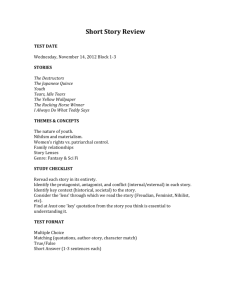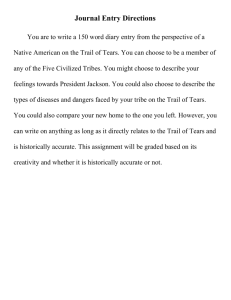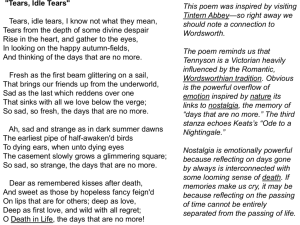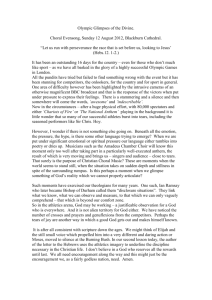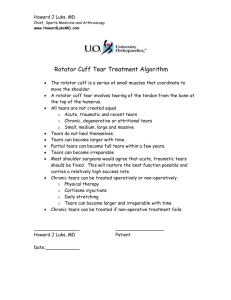All Saints Sunday - Wicker Park Lutheran Church
advertisement
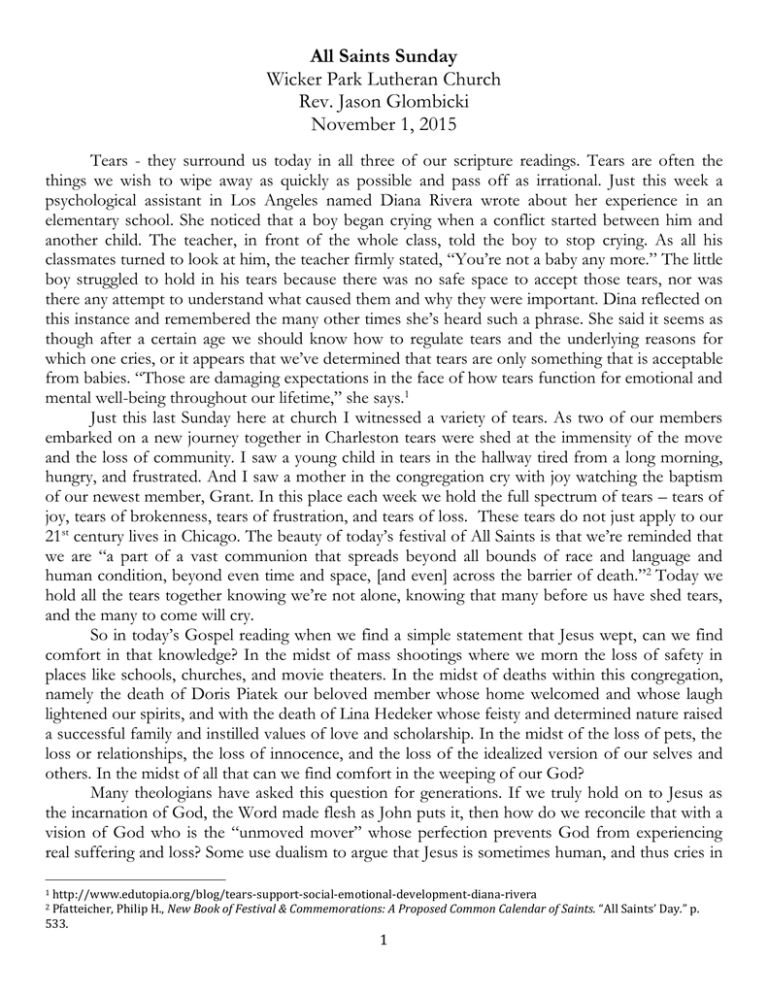
All Saints Sunday Wicker Park Lutheran Church Rev. Jason Glombicki November 1, 2015 Tears - they surround us today in all three of our scripture readings. Tears are often the things we wish to wipe away as quickly as possible and pass off as irrational. Just this week a psychological assistant in Los Angeles named Diana Rivera wrote about her experience in an elementary school. She noticed that a boy began crying when a conflict started between him and another child. The teacher, in front of the whole class, told the boy to stop crying. As all his classmates turned to look at him, the teacher firmly stated, “You’re not a baby any more.” The little boy struggled to hold in his tears because there was no safe space to accept those tears, nor was there any attempt to understand what caused them and why they were important. Dina reflected on this instance and remembered the many other times she’s heard such a phrase. She said it seems as though after a certain age we should know how to regulate tears and the underlying reasons for which one cries, or it appears that we’ve determined that tears are only something that is acceptable from babies. “Those are damaging expectations in the face of how tears function for emotional and mental well-being throughout our lifetime,” she says.1 Just this last Sunday here at church I witnessed a variety of tears. As two of our members embarked on a new journey together in Charleston tears were shed at the immensity of the move and the loss of community. I saw a young child in tears in the hallway tired from a long morning, hungry, and frustrated. And I saw a mother in the congregation cry with joy watching the baptism of our newest member, Grant. In this place each week we hold the full spectrum of tears – tears of joy, tears of brokenness, tears of frustration, and tears of loss. These tears do not just apply to our 21st century lives in Chicago. The beauty of today’s festival of All Saints is that we’re reminded that we are “a part of a vast communion that spreads beyond all bounds of race and language and human condition, beyond even time and space, [and even] across the barrier of death.”2 Today we hold all the tears together knowing we’re not alone, knowing that many before us have shed tears, and the many to come will cry. So in today’s Gospel reading when we find a simple statement that Jesus wept, can we find comfort in that knowledge? In the midst of mass shootings where we morn the loss of safety in places like schools, churches, and movie theaters. In the midst of deaths within this congregation, namely the death of Doris Piatek our beloved member whose home welcomed and whose laugh lightened our spirits, and with the death of Lina Hedeker whose feisty and determined nature raised a successful family and instilled values of love and scholarship. In the midst of the loss of pets, the loss or relationships, the loss of innocence, and the loss of the idealized version of our selves and others. In the midst of all that can we find comfort in the weeping of our God? Many theologians have asked this question for generations. If we truly hold on to Jesus as the incarnation of God, the Word made flesh as John puts it, then how do we reconcile that with a vision of God who is the “unmoved mover” whose perfection prevents God from experiencing real suffering and loss? Some use dualism to argue that Jesus is sometimes human, and thus cries in http://www.edutopia.org/blog/tears-support-social-emotional-development-diana-rivera Pfatteicher, Philip H., New Book of Festival & Commemorations: A Proposed Common Calendar of Saints. “All Saints’ Day.” p. 533. 1 2 1 today’s Gospel, and other time Jesus is divine, with the absence of emotion. Some argue that Jesus weeping was a rhetorical ploy, a way to arouse sympathy within the crowd by condescending to their weakness. Yet, common in each of our attempts is the fantasy that Jesus is without emotion, the commonality is our reticence to admit that God is affected by suffering and loss. Let’s face it – the God I see and know in the scriptures and in the world is one who does weep for death, who does mourn and feel emotion. Our God knows pain and suffering. In that knowledge, I know that I’m not alone, knowing that God understands our suffering and pain, knowing that God has experienced loss, in that I find comfort. Yet, there’s a beauty deeper in the text than only our God weeping, for Jesus is more than the company to our misery. So the scene continues as Jesus demands the stone to be rolled away. Then in a dramatic way Jesus demands the dead Lazarus to “come out.” It’s those standing there and watching that Jesus tells to unbind the dead man to let him go. Here in the midst of death Jesus beckons Lazarus to go forth. Our God is the one who brings resurrection to death. We are reminded to live as though the death has no power over our days, for in both life and death we belong to God. This way of living as though death doesn’t exist is what some theologians call “realized eschatology.” Eschatology coming from the Greek words ἔσχατος meaning "last" and -λογία meaning "study", so essentially eschatology is the study of 'end things'. Specifically “realized eschatology” looks at the world noted in our first two readings today from both Isaiah and Revelation and says these things are not talking about some future apocalyptic, “it’s the end of the world as we know it” type event. Rather the scriptures note a rebirth that Jesus institutes – a rebirth through his entire ministry it is that rebirth that then lives on into his lasting legacy. With realized eschatology we become continually engaged in a process of becoming. We are resurrected, we are made new, and we are set free. So then much like the new life that Jesus gives Lazarus, so too we are given new life, perhaps even new life through our tears. Mark Fenske, a professor of neuroscience writes that “one theory of crying is that it helps the body to return to a state of homeostasis after being overly aroused -whether positively or negatively.” So right after that peak in arousal, whether it's immediately after walking down the aisle at a wedding or crying after the loss of a loved one, tears might help bring a person back to a baseline level of functioning.3 Just as Jesus and those gathered at Lazarus’ tomb wept and experienced resurrection, so too God joins with us in our tears and those very tears begin the process of bringing us back to new life. The tears we shed might actually be a part of the process of bringing new life and part of process of learning that nothing can separate us from God’s love. This realization that God’s eternal presence goes beyond death is what it means to be a saint. It is this recognition of God’s constant presence in death and in life that makes each baptized person a saint. Since our last All Saints Sunday we’ve baptized 13 people into the holy sainthood of this church. In baptism we recognize that death does not have the final say, rather God’s love and grace knows no bounds. We recognize that our baptismal waters claim us and that God gives us the holy gift of tears and emotion – tears and baptismal water that wash us and reform us. These waters that open us up to new potential and new life. 3 http://www.huffingtonpost.com/2014/01/10/tear-facts_n_4570879.html 2 On this All Saints Sunday we give thanks for all the saints – those baptized and alive, along with those no longer living. Today we especially remember those saints who have died and the impact they’ve had on our lives. We mark this day as special as we remember those influential people. To do that today we’re going to participate in adding to the cairn in our space. A cairn often denotes something important. This cairn is made of over 150 people’s clay pieces that represent their loss. At the same time the cloud hanging overhead represents their hope. While looking at this cloud, I couldn’t help but be reminded of how clouds are made of little droplets of water – water like our tears and the water of our baptism, in essence the water of our sainthood. In the silence that follows the sermon take some time to hold on to the rock you’ve been given. Remember those people you’ve lost in your life, remember all the saints gathered together. Look at the cloud over this cairn and think of the cloud of witnesses, all the saints of God gathered here in this place. Then after the silence we’ll gather together to give thanks for the many gifts of the saints gone before us. We’ll gather to sing and give thanks for God’s holy gift of tears. We’ll gather this day on holy, tear-saturated and hope-filled ground where we trod together. Amen. 3
